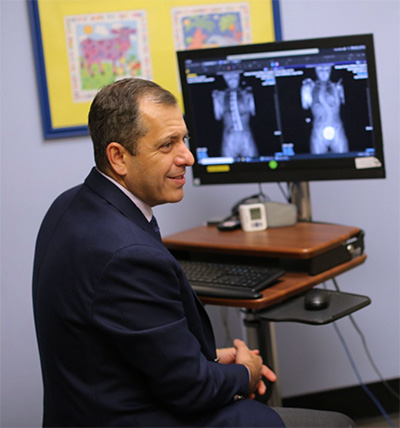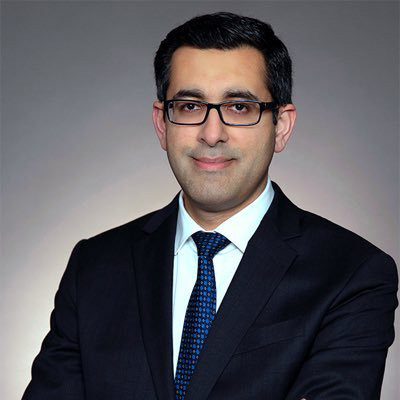The practice of spine surgery is undergoing a transformation due to advances in technology, such as robotics and navigation systems, that have been developed to augment the skills of spine surgeons. While technologies that can improve outcomes are certainly a valuable adjunct to surgical practice, adopting these technologies requires thoughtful consideration.

Dr. Michael Vitale
“When we think about these enabling technologies, we have to remember that the formal terms are robot-assisted and navigation-assisted,” says Michael G. Vitale, MD, MPH, Chief of Pediatric Spine and Scoliosis Surgery in the Department of Orthopedic Surgery at NewYork-Presbyterian/Columbia University Irving Medical Center and a member of the Och Spine at NewYork-Presbyterian program. “These are types of technology that should guide what we are doing and enhance what we ourselves are able to perform without relying on them.”
Surgical or intraoperative three-dimensional navigation is an enabling technology that has emerged in the last several years and continues to undergo iterative changes. “Navigation technology provides us with a three-dimensional view of the spine in the operating room, allowing us to see where we are placing screws and implants,” says Dr. Vitale, who also serves as Vice Chair, Quality and Strategy, Orthopedic Surgery, and the Ana Lucia Professor of Pediatric Orthopedic Surgery and Neurosurgery at Columbia. “The disadvantage of surgical navigation is that it's imperfect; it does not work 100 percent of the time. The concern that many of us have, therefore, is that complete reliance on technology such as navigation might get us into trouble, particularly if a surgeon does not have significant experience operating without the use of a guidance system.”
Dr. Vitale emphasizes this point with an analogy to pilots and airmanship. “Historically, pilots had many more hours of true flying – from takeoff to landings,” notes Dr. Vitale. “With the arrival of navigation and autopilot technology, pilots began flying fewer hours in which they are actually controlling the plane. Many believe that this has been at the cost of safety in the air as some of the airplane accidents that have occurred have been thought to be due in part to pilot error because of a reliance on technology. Taking this comparison into the OR, I believe there needs to be a balance between the application of navigation tools and our traditional surgical skills, which rely on surgical anatomy, understanding of the anatomy, and our own freehand dexterity.”
I use surgical navigation for cases involving increased complexity, unusual anatomy, or when normal surgical landmarks are not available due to a previous spine surgery. This balance of technology and surgical experience allows me to take care of any pediatric patient with any spine deformity in the safest manner.
— Dr. Michael Vitale
In his practice, Dr. Vitale currently uses navigation technology in about 10 percent of his cases and the traditional approaches of performing surgery for the other 90 percent. “This allows me to stay connected with the anatomy and be my safest surgeon. If a patient has had a prior spine surgery, this can change their anatomy, rendering the new surgery more complicated. In these situations, surgical navigation provides some advantages. So I use surgical navigation for cases involving increased complexity, unusual anatomy, or when normal surgical landmarks are not available due to a previous spine surgery. This balance of technology and surgical experience allows me to take care of any pediatric patient with any spine deformity in the safest manner.”
Consider the Learning Curve
In a webinar hosted on April 21, 2022 by The Safety in Spine Surgery Project (S3P), navigation and robotic technologies were discussed in great length by a panel of spine surgery experts who provided a dynamic exchange about innovation, patient safety, and how to adopt new technologies without creating iatrogenic harm to patients in the process.
“This is really what it comes down to…getting better at adopting new techniques, procedures, and technologies without diminishing our safety margin,” says Dr. Vitale. “We're taking care of fragile patients with significant problems and there’s a lot at stake. Conventional radiology is still what we use in the majority of patients, but as an example, I recently used an intraoperative scanner on a young patient who had a very complex anatomy between their cervical spine and thoracic spine with an unusual hemivertebra. Surgical navigation was helpful in this situation, where the patient’s anatomy was abnormal and visualization difficult. I think we all are trying to understand how quickly to make this transition to the newer technologies, understanding that the early versions of technologies that are coming on board are not mature and not perfect.”
“Technology in spine surgery is being introduced at a very fast pace,” says Zeeshan M. Sardar, MD, an orthopedic surgeon specializing in spinal deformities in adolescents and adults in the Department of Orthopedic Surgery at NewYork-Presbyterian/Columbia and a faculty member on the S3P webinar panel. “We have multiple types of navigation or CT scan systems, at least four types of different robots, numerous options for ultrasonic bone cutting, and then we have patient-specific rods. More and more, we are seeing augmented reality based on navigation, but also based on overhead cameras that can register without the use of CT scan or X-rays, and then, finally, there’s virtual reality. And these are just the technologies that are being used inside the operating room. In essence, I think technology is infiltrating every aspect of medicine and spine care, and as physicians, I think it is our responsibility to ensure that this is actually advancing the field and also in a safe way.”

Dr. Zeeshan Sardar
Adopting New Technology: Taking Steps for Safety
In his presentation, Dr. Sardar spoke about technology grouped into two categories – conceptually new and contextually new. Conceptually new technology is technology that has not been used previously and therefore the safety profile is unknown and its potential uses are still in development. In the field of spine surgery, contextually new technology predominates in that the technology already exists, but is being introduced into a new environment.
“While we know the safety profile of contextually new technology to some extent, assuming it has been well studied and results published, a fair amount of training will be needed to use the new technology safely,” notes Dr. Sardar. “The training is not just for surgeons. It should involve all stakeholders, including surgeons, nurses, scrub techs, residents, and fellows.”
Once the team has been trained on the basic technology, Dr. Sardar strongly encourages the use of simulation training, which can gauge competence in the technology before it is used in the OR. These simulations should incorporate patient scenarios where the technology has been known to fail, so that a plan is in place to respond if failure occurs during a patient case. He also recommends that an expert user be present in the OR who can monitor the first few cases using the new technology and provide feedback.
Additional recommendations for adopting new technologies include:
- Identify criteria for initial patient selection before expanding the indication for its application to non-traditional applications, for example, if currently used in the lumbar spine, exploring its application to the cervical spine
- Introduce the technology with a small group of users who become expert and can support new users
- Know the known failures of the technology
- Always have a back-up plan in case the technology does not provide what is needed if faced with unexpected anatomical or other circumstances when performing the surgery
- Conduct regular surveillance with internal users to determine ongoing safety and to identify any new issues or complications that may need to be addressed
- Participate in global surveillance, including adding results to data registries, such as the American Spine Registry, and through multicenter collaborations and research projects





